The Science and Art of Better Home Lighting
Understanding our field of vision offers a novel approach to lighting for comfort, work, safety, and more.
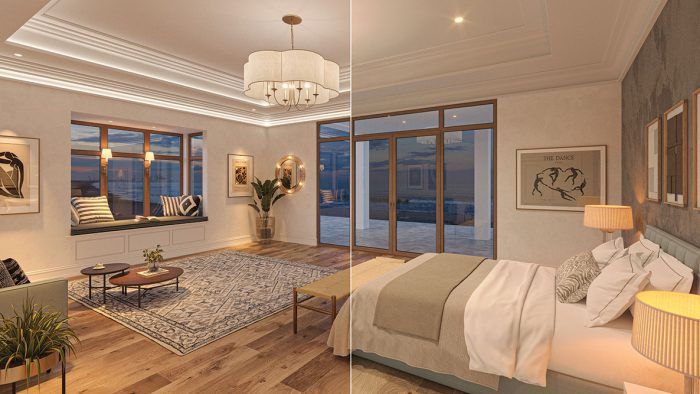
It seems that everyone has a valid complaint to lodge against the current state of lighting in our homes: This light flickers; that light is too blue; this one is too yellow; that one burned out long before it should have. At the same time, we are bombarded with promises: This bulb will help you stay awake; that light will help you sleep; this one will last forever. It’s no wonder a recent New York Magazine article called their pick for the best LED, “The Best Bad Bulb.” The lighting in our homes is arguably getting worse, despite our ability to deliver better electric light than at any other point in human history.
There is a better way to light a home, and the answer lies in an updated tool kit. Somewhere between unbelievably expensive lighting and regrettably terrible lighting is a happy middle for most of us. With our tongues firmly in our cheeks and with due respect to the inspiring authors of The Pretty Good House, let’s call it Pretty Good Lighting. In this article, I’ll dig into the science behind better home lighting first, and then provide concrete examples in our homes’ most important spaces.
This new alternative to lighting starts with an amazing part of human biology: the eye. Once we understand how the eye captures light and translate that into a continuum of practical zones, getting the right light in the right place is easier. We minimize bright lights in the glare zone, bounce light off ceilings and walls in the comfort zone, provide strong bright light in the work zone, and add low light in the safety zone.
Reducing material costs, using adjustable monopoint lights, and getting better light out of shaded decorative fixtures can help keep costs and environmental impact down, but I also recommend control systems for most of my projects. Smart systems like those from Lutron Homeworks, Vantage, Savant, or Control4 can simplify the operation of good lighting so that homeowners get the right light at the right time, morning, noon, and night.
It’s all about the eyes
Everything we see—the trees outside, the tools in our hands, the smile of a loved one—comes into our eyes in waves of light, but not all light is treated the same way by our body. The retina (the lining of densely packed light receivers in the back of our eye) is divided into different sections, each with its own unique makeup of cells. Two retinal regions are important to understand here.
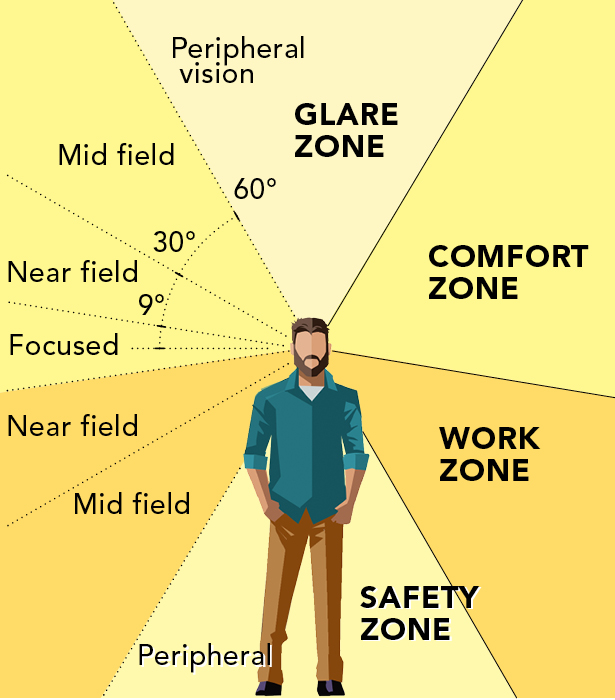
Most of us are familiar with peripheral vision. This is the ability to pick up movement out of the corners of our eyes. The part of our retina responsible for this is packed with highly sensitive rod cells. A change in light to our side, like an approaching car, cues us to swivel our heads, but our peripheral vision does not discern detail. When we turn our heads toward the approaching car, we are reorienting our body to make use of the near- and mid-field sections of our retina. These areas are more densely packed with cone cells. The tightest pack of these cells is in an area of the retina called the fovea, and it is in this tiny region that our vision peaks. We use foveal, or focused, vision to read words on the page of a magazine, which is all but impossible using peripheral vision.
All too often in our homes, we put light into our eyes in the wrong places. We tend to cluster glare-inducing lights in our peripheral vision, where the rods will be most harmed by them, and leave the areas where focused vision is needed and seeing details is important dimly lit. When we understand how the human eye works, we can build lighting solutions that create a better experience.
The four lighting zones
Those of us in the lighting industry have made numerous attempts to boil down the science and art of lighting into something our clients can understand. You may have heard about “layers of light” or “task, ambient, and accent” light. These can be useful concepts and terms, but they too-often leave out something important, or are difficult to perceive and implement. With the human eye as our guide, it may be useful to think of our homes in terms of lighting zones instead. Determining the right light for our glare zone, our comfort zone, our work zone, and our safety zone can be an easier way to categorize and plan for lighting.
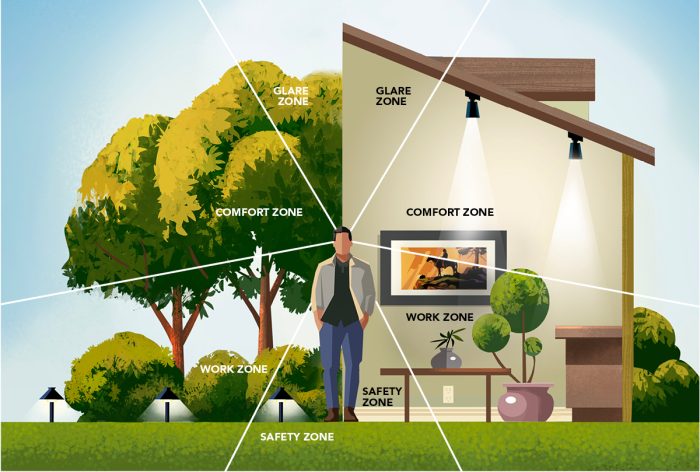
1. Comfort Zone: Outdoors, our near field of vision is filled by light bouncing off mountains, buildings, trees, and anything else we see. While we are conscious of the beauty of the landscape, it is reflecting something we miss most of the time: unrestricted soft, cool light from the sky. Indoors, we simply need to fill this area with soft, reflected light just as we see outside. This zone is where we place windows, which give us just that kind of light during the day. Where there are no windows, we should be bouncing light off the ceiling and the walls, highlighting artwork, finishes, and stone fireplaces. When we get the soft light we need in our eyes to feel comfortable, the house starts to look better, too.
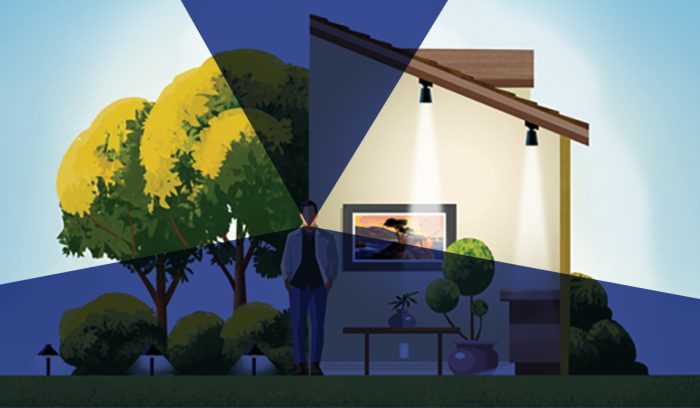
2. Work Zone: Outside, we have enough work-zone light on a sunny day to perform brain surgery, but inside this area is often the darkest in the room instead of the brightest. We need good, strong light where our eyes and hands meet, typically in the near field of vision around our waistline. Lowering light sources below our eyes helps minimize glare. Undercabinet lighting in kitchens and desk lamps in offices are good examples, but there are other ways to deliver this kind of light too. Some wall sconces and pendants, as well as carefully placed and shielded adjustable downlights, can deliver good, strong light where needed. It is where our hands work that we need this light: on counters, desks, the pages of books, a workbench, or the knitting project in our lap.
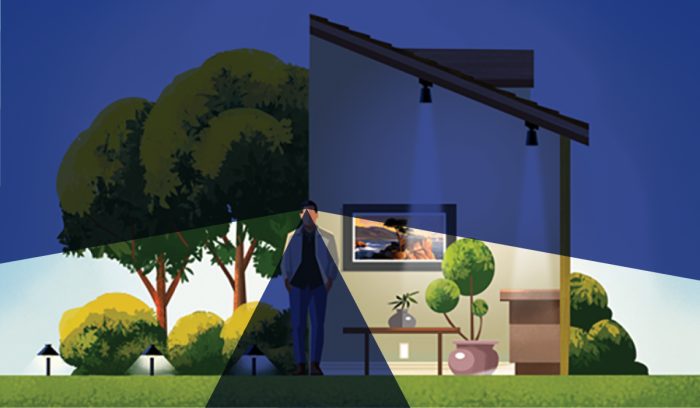
3. Safety Zone: After sunset, we need to use as little light as possible while protecting our ability to move around a space safely. The science behind this is compelling. Academic studies link too much light at night with increased depression and anxiety, and worse. At night, we should eliminate light in our glare zone, and reduce it in our comfort zone. That means almost no overhead light and only what is necessary for our work zone. Though a bright streetlight could efficiently illuminate our landscape, knee-height path lights are far more comfortable and plenty safe. Inside, too often we use the equivalent of a streetlight (like recessed downlights) when we should be using
in-wall step lights, toekick lighting, and light under bar tops and fireplace hearths.
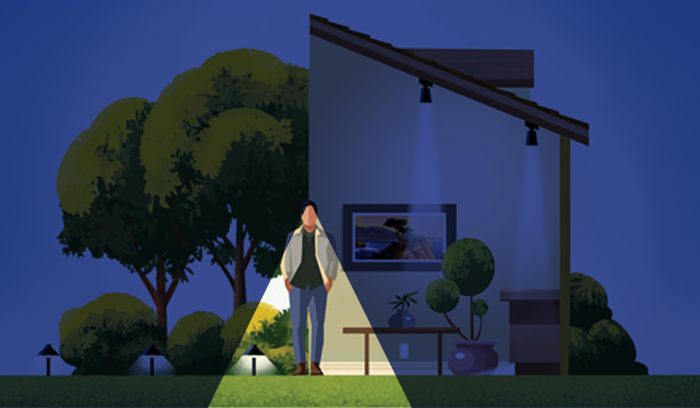
4. Glare Zone: Most humans feel better on a sunny day than a cloudy day. But when the sun is directly overhead, we are more comfortable wearing a hat, because our peripheral vision is the most susceptible to glare. Light shining directly overhead is in the glare zone, and it is the same inside our house. Sadly, this is where we most often pack the ceiling with downlights or fixtures with exposed light bulbs. These are the worst offenders of glare. They push very strong, unshielded and unshaded light directly into our eyes at the worst angle. Keep light out of this zone as much as possible and avoid disc/wafer lights altogether, except in strictly utility spaces, like closets. Instead, use adjustable recessed lights at the perimeter of the room where the light can be bounced off the wall. You can also use decorative fixtures with soft light-filtering shades instead of bare bulbs. And, you can hide narrow strips of LEDs in architectural details.
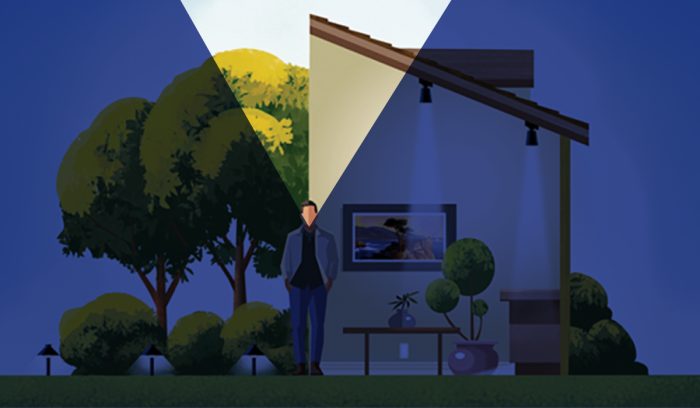
Kitchens: Lighting the work zone
Nowhere else is light for our hands, or light in the work zone, more important than where we regularly use large, sharp knives right next to our fingers. This light ideally comes from below our eyes to minimize glare and maximize light in as few watts as possible. That’s why we love undercabinet lighting, which can be glare- and almost shadow-free. Mount LED strips about 3 in. back from the front of the upper cabinets, pointed straight down, for the most efficient and strongest light on the counter.
That approach is not possible everywhere, so you may need to lean on adjustable downlights to fill in the gaps. Near upper cabinets, put these directly over the counter and tilted just a bit to wash the face of the cabinets. This puts great light in the work zone and bounces light into the room in the comfort zone, a double benefit.
Kitchen islands are also in the work zone. The majority of decorative fixtures today look pretty but deliver most of their light to the ceiling, where it is wasted, or directly into our eyes, where it is uncomfortable. There are nicely shaded pendants and chandeliers that deliver their best light downward, but often we will use recessed adjustable downlights between the pendants to push light into the work zone. This allows the homeowner or designer to choose beautiful fixtures that look best when dimmed but still deliver useful light for rolling out sugar cookies.
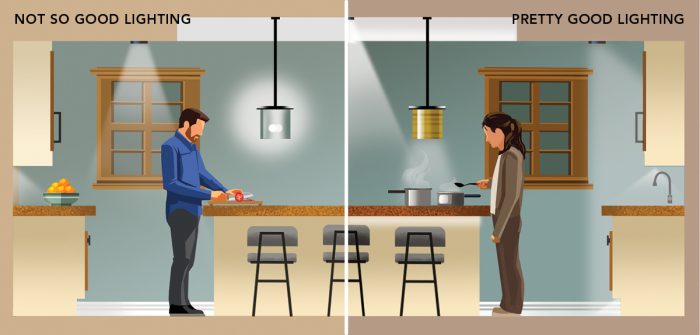
Living rooms: Lighting the comfort zone
Light in the comfort zone is important everywhere, but living rooms without it are particularly unwelcoming and uncomfortable. The idea behind better lighting in the comfort zone is simple: Bounce light off the ceiling and walls. In a living room, this can mean indirect light from coves or illuminated crown molding. Sometimes we install a single backband-style trim piece, about 12 in. to 18 in. below the ceiling, with a shallow channel routed to conceal a thin LED strip pointed upward. The result is like soft light from the sky; a great addition for comfort.
Indirect lighting on the ceiling alone does not make a space perfect; light bouncing off the walls in our near field of vision is also needed. This second layer of light can come from something as simple as floor lamps with large, soft fabric shades, or it can be built into homes with adjustable downlights or monopoint lights aimed at art or wall features like fireplaces and stone details. Where there are bookcases, light inside of them bounces off the books and fills the comfort zone with soft light, and the room looks more inviting, too.
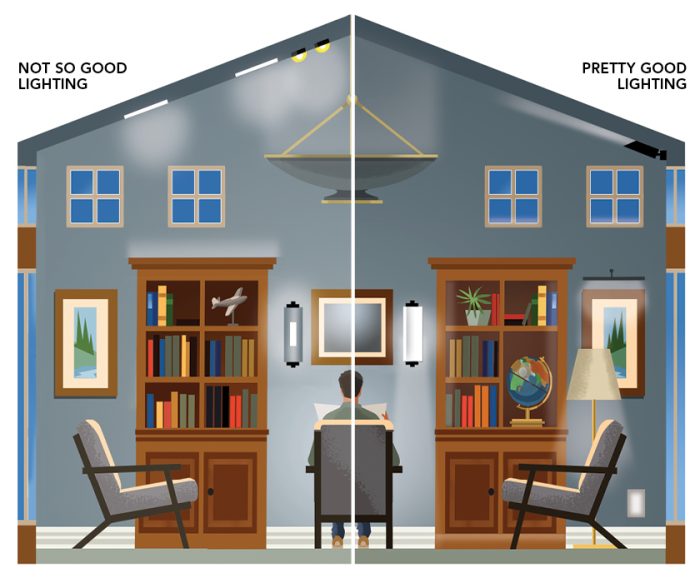
Bedrooms: Lighting the glare zone
Light at night, or LAN, is categorized by the European Union as “possibly carcinogenic.” In other words, too much of the wrong LAN can be bad for your health. For starters, LAN disrupts the body’s ability to release melatonin, a sleep hormone, and makes it harder for us to fall and stay asleep. Reducing LAN means reducing bright overhead light sources, which is exactly the opposite of what most of us have in our homes.
Downlights pointed straight into our glare zone should be eliminated or minimized in bedrooms. Instead, use adjustable downlights around the perimeter of the room to highlight art, bookshelves, the headboard, or wall features, or even simply to chase shadows away from the corners. We usually do not stand right up against a wall, so that puts the recessed adjustable fixtures outside of the glare zone.
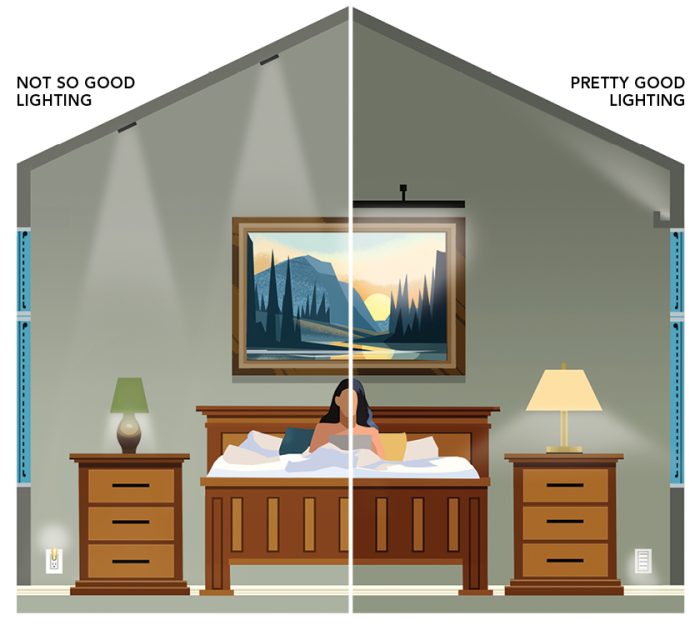
Bathrooms: Lighting the safety zones
Bathrooms need good soft light in the comfort zone, minimal light in the glare zone, and strong light in the work zone for taking out contact lenses and other common grooming tasks. Late at night, though, a properly illuminated safety zone can minimize sleep disruption and maximize safety and comfort.
It can be a distance to travel from the bed to the water closet in the middle of the night. Path lighting on a motion sensor can safely and softly guide us in the right direction, and a built-in step light in the toilet room itself can keep us from turning on other lights. Plug-in night-lights are a quick fix, but receptacles are never in the right place and most night-lights shine too much in my face for real comfort. Light in the safety zone can also come from vanity toekicks or below floating vanities, which reduces light in our eyes even more. Linear LED strips can fit in the smallest of spaces, making it easier than ever to deliver light where we need it, when we need it.
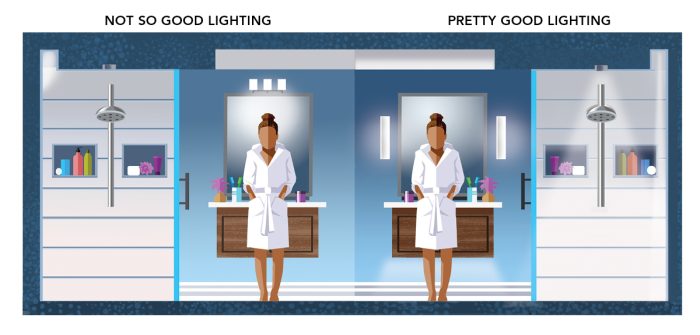

Home offices: Lighting all the zones
We focused on one zone of light in each of the examples above, but almost every space needs protection in the glare zone and the right light in the comfort, work, and safety zones. For example, a home office often needs different kinds of light for different uses.
Light in the work zone can be provided by overhead lighting, but this is likely to put bright spots in the glare zone where it can cause eyestrain, headaches, and fatigue. If the home office will be used primarily during the day and for video-conferencing, a pair of standard table lamps with soft fabric shades will be more comfortable and make us look better on camera. Traditional desk lamps, like the swing-arm lamps with dark shades, keep light out of the eyes and are great at night. Light in the comfort zone can be provided by wall sconces, or by indirect light bounced off the ceiling from coves, from behind crown molding, or from the tops of cabinets and shelves. Paired with light bounced off art and emanating from built-ins, this soft light will help the space feel more comfortable and relaxing.
The glare zone above our heads needs to be kept dim or free of light sources, so decorative fixtures overhead should be dimmable, shaded, or, ideally, both. Here’s a good rule of thumb: If you can see a light bulb, it’s a bad thing. Choose overhead fixtures that shade, diffuse, and spread the light over a larger surface area for reduced glare and push downlights to the perimeter where they will contribute to the comfort zone.
A layer of light in the safety zone may be a good idea. Light in cabinet toekicks, or from built-in step lights on the wall, can be a nice addition to a home office. This may be the least critical layer of light, but you might be surprised how quickly lighting in the safety zone becomes your favorite lighting in the house.
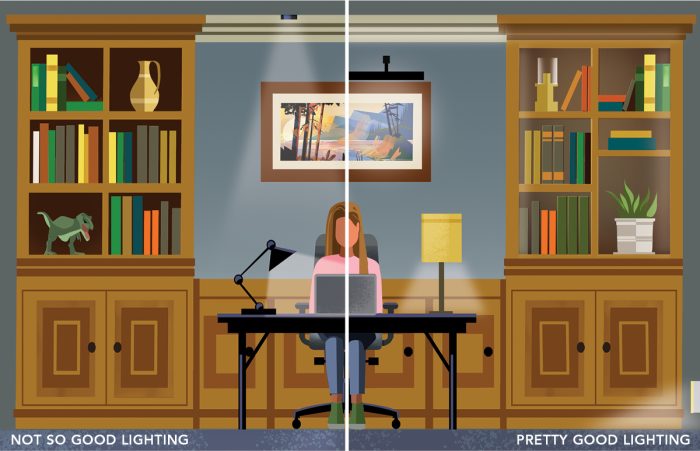
Lighting product tips
Time and temperature: Natural light—the benchmark by which all electric light falls short—is dynamic, constantly changing over the course of a day from sunrise to sunset. Light in our homes is most often binary (on/off) and, even when dimmed, a single unchangeable color temperature. The debate over the “right” color temperature to use is often misguided; 3000K, 2700K, and 4000K are the right color temperature at some point in every day and the wrong color temperature all the rest of the day. In other words, the best color temperature inside is the same as whatever the sun is doing outside.
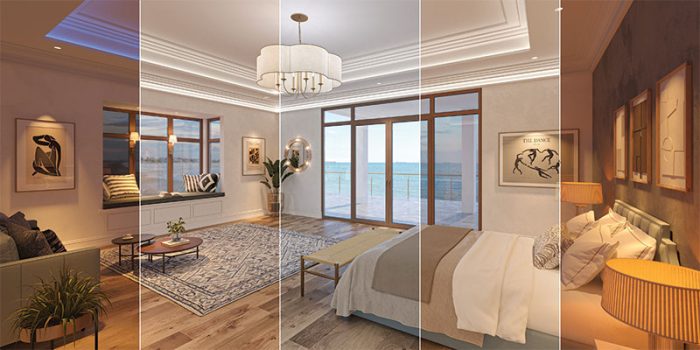
Dynamic white light, often called “tunable” white light, is usually delivered from a pair of LED chips, one warm (amber) and one cool (blue). Used in different amounts, these chips can combine to create the soft glow of candlelight, the brighter white of late morning, and even the crisp, cool white of mid-afternoon. When connected to an intelligent control system, like Control4’s Vibrant Lighting, these tunable sources make it possible to get just the right light when you need it. Consumer-friendly smart bulbs, like the GE Cync bulbs, are an easy and inexpensive way to experiment with the technology or roll it out in your own home today. Now, when clients ask you to recommend a color temperature, you can recommend them all.
Refocus your downlights: There is a disturbing trend sweeping production homes and seeping into far too many custom builds: the disc light. Misleading marketing confuses some into thinking these are similar to recessed downlights when they are not. These thin, wafer-like fixtures are inexpensive and easy to install to a simple junction box, but they fill the glare zone with unshielded bright light. Even worse, they produce very little usable light, instead delivering “blobs” of light near the ceiling that leave the rest of the room feeling dark and dingy. Limit the use of disc or any common downlights to closets, garages, and utility rooms.
Better alternatives are recessed adjustable downlights and monopoint spotlights. Common downlights only illuminate the floor, at best. Mostly they create glare in our eyes. Adjustable lights enable us to point the light at walls, art, cabinets, and fireplaces to fill our comfort zone with soft, indirect light. The WAC Lighting Volta downlight shown here is a high-performing recessed adjustable downlight that comes in 2-in. and 3-in. sizes and can cover most residential needs.
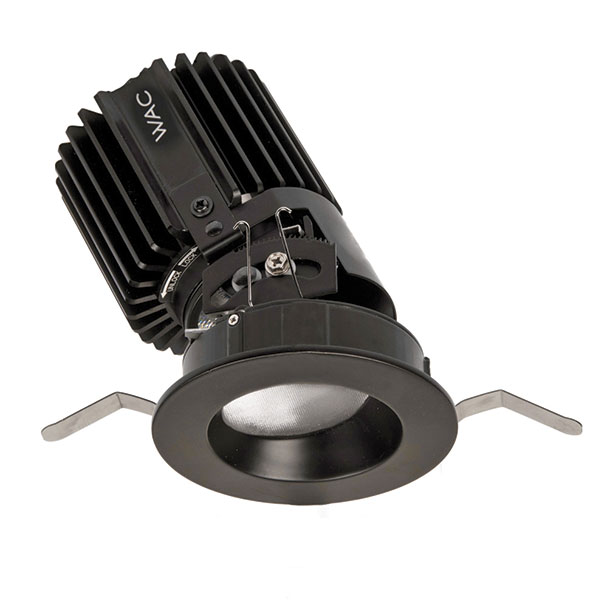 |
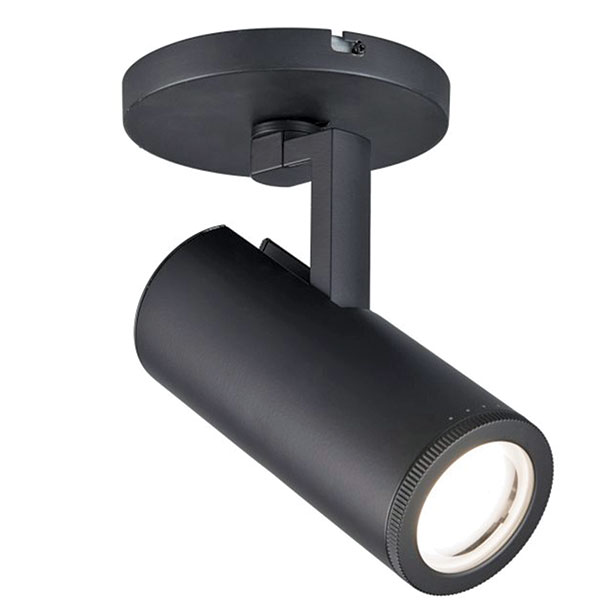 |
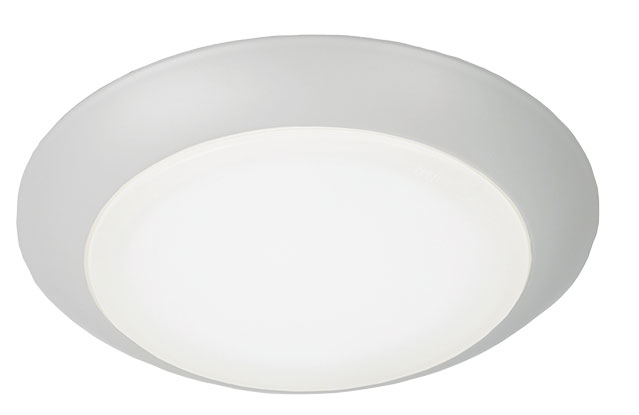
Monopoints are a great alternative to recessed adjustable downlights and arguably the best light for sloped ceilings. Essentially a single track light, these mount easily to a junction box, minimizing ceiling intrusions and simplifying installation. Their increased adjustability, often up to 90° off-axis, allows them to correct for ceiling slope and even aim at the walls and features in our comfort zone. Monopoints with shielding options are even better. The WAC Lighting Paloma monopoint shown here features a rotating lens ring that changes the beam size, easily flooding a stone fireplace or spotlighting a piece of art.
Lowering voltage and costs: We use a staggering amount of copper for our homes’ lighting, despite LEDs using one-tenth of the power of our old incandescent models. Every LED is already low-voltage, but many have a disposable driver inside that steps down the 120v house power to the lower-needed voltage. When LEDs fail, it is most often these cheap drivers that burn up, not the light source itself. Combined with the use of excess copper, lighting has become wasteful.
Low-voltage systems, including the brand-new Class 5 default-managed power systems just now emerging, use thin wires and remote drivers to power LED light sources throughout a house. Remote drivers, like those shown here in the ReNetA system from LumenCache, are better-built and easily swappable—more easily than swapping out a breaker while leaving the ceiling intact. ReNetA can power many different kinds of light sources, including tunable-white-light sources that mimic natural-light cycles.
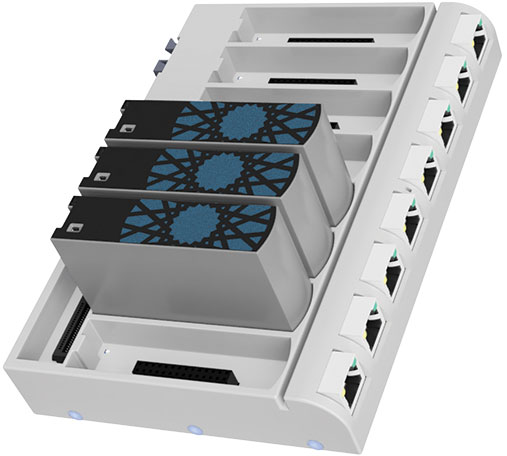
Even switches can now be low-voltage and entire lighting systems can be wired with Cat5 or Cat6 wiring. Most low-voltage systems are Class 2, meaning they can be installed by lower-skilled team members during labor shortages. And, according to an example provided by LumenCache, the savings can be convincing: The costs of wiring could be reduced by 75% and copper usage by similar numbers. It’s a better solution for the planet, and for already-strained project budgets.
David K. Warfel is a lighting designer, author, and educator. Photo rendering by Michael Weber, courtesy of Light Can Help You. Drawings by David Moore.
RELATED STORIES
- Light a Bathroom Right
- A Detailed Illustration of Ideal Kitchen Lighting
- Bright Ideas for a Well-Lit Deck

From Fine Homebuilding #321
To view the entire article, please click the View PDF button below.
Fine Homebuilding Recommended Products
Fine Homebuilding receives a commission for items purchased through links on this site, including Amazon Associates and other affiliate advertising programs.

Pretty Good House

Code Check 10th Edition: An Illustrated Guide to Building a Safe House

The New Carbon Architecture: Building to Cool the Climate













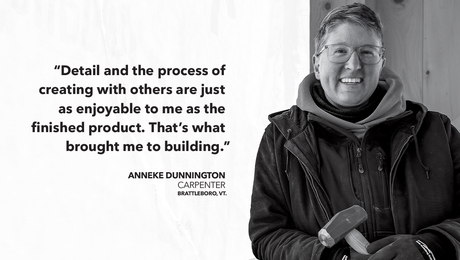












View Comments
I can’t tell you how much I appreciate this article. Quality of light is so undervalued. Thank you for writing this!